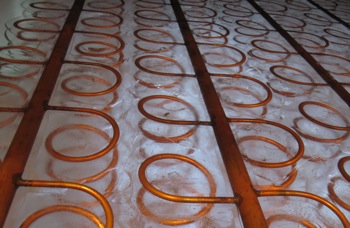Kristine Wong is a student at UC Berkeley’s Graduate School of Journalism. She is currently serving an internship at KQED Climate Watch.

Latest technology designed to improve grid performance, decrease peak energy demand
By Kristine Wong
When the hot weather hits town, everyone wants to cool off. Some down a cold drink, others take a dip in the pool. But most just turn on a switch–for the air conditioning or the fan. But when everybody jumps for the switch at the same time, the electrical grid is pushed to the max, which can lead to blackouts, as well as use of peak energy generators. Peak generators are used just a few times during the year but use more fossil fuels than other power plants.
Now, with the realization that climate change is upon us, along with advances in technology, there are new ways to stay cool while conserving energy and cutting carbon emissions at the same time. Several products showcased this week at the Edison Electric Institute conference in San Francisco seem to have the potential to do just that.
Take SmartMeter, for instance. The program from PG&E will monitor and control home energy use by satellite, and adjust energy consumption accordingly by supply and demand via a few palm-sized monitors. Right now, it’s still in demonstration mode. But PG&E will offer voluntary enrollment in 2010, and aims to outfit all households by 2012, according to Peter Chan, a PG&E supervisor in Demand Response Operations (“demand response” is industry-speak for systems that can adjust electrical use at the consumer end). Redistributing energy as needed avoids the need to bring peak generators online. Customers lower their energy bills and can also override the system if, say, that load of laundry really needs to go into the dryer now.
The Ice Bear aims to reduce the energy needed to cool low-rise buildings (under 3 stories), using rooftop energy storage that works in conjunction with the building’s air conditioning system. Developed by Windsor, CO-based Ice Energy, a rectangular unit about the size of a sub-compact car sits on the roof and stores energy at night. It releases the energy during peak daytime periods.
The company claims that using off-peak stored power during peak hours reduces carbon emissions by 40%. And the key technology is–well, ice. Major components include a block of ice threaded with a network of copper coils designed to keep the ice from melting, a condenser that makes the ice, and a controller that achieves the building’s thermostat level most efficiently in conjunction with the building’s air conditioning system. The unit uses R410, a refrigerant which the company says is more efficient than more commonly used refrigerants such as R-22. The system comes with a price tag topping $8000 but utilities are apparently bullish on Ice Bear and have bought thousands of units–13,000-15,000 units can conserve up to 50 megawatts, according to company spokeswoman Therese Wells.
The conference also featured previews of potential “game-changing” technologies. PG&E panelist and Director of Emerging Clean Technologies Hal La Flash told the audience about a solar “nantenna,” a flexible panel that may replace solar panels in the future. And Mike Howard, Senior Vice President of Research & Development at the Electric Power Research Institute, spoke of being 5-to-10 years away from the debut of LED lighting that has the potential to be even more energy efficient than compact fluorescent bulbs.
